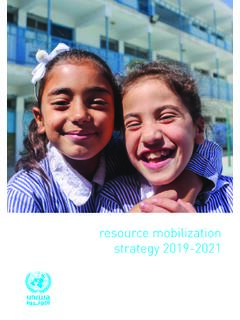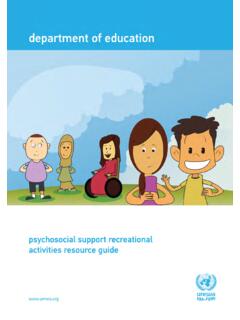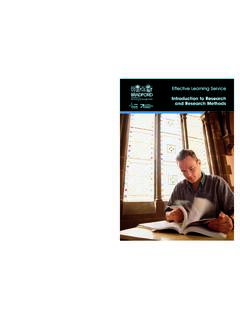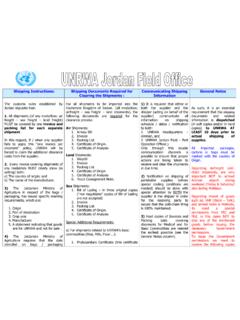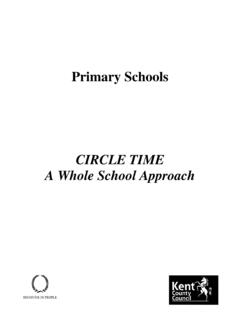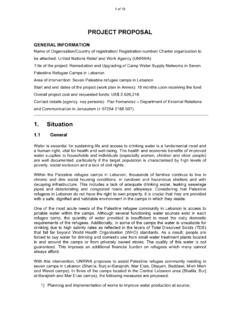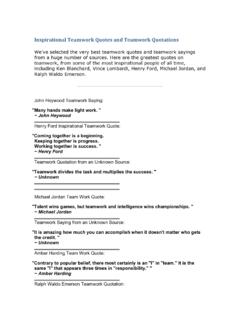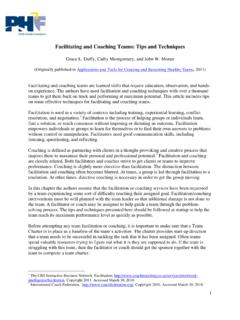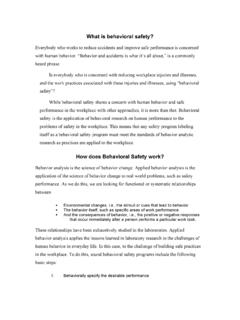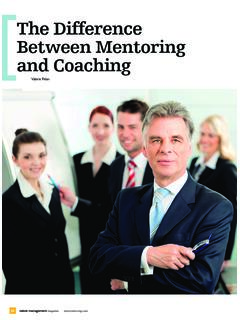Transcription of Student Achievement through Staff Development - UNRWA
1 National College for School Leadership 2003 1 ` Student Achievement through Staff Development Bruce Joyce and Beverley Showers In: Bruce Joyce and Beverley Showers, 2002, Designing Training and Peer coaching : Our needs for learning, VA, USA, ASCD Understanding about teacher use and acquisition of knowledge and skills is fundamental to our understanding about how and in what circumstances teachers use research and evidence to develop their practice. In this chapter the authors explain how they have developed and refined their vision for training as the means by which new knowledge is added to the teacher s professional repertoire. They suggest that over the years since they first advocated coaching as an essential ingredient in using new knowledge to change practice in the early 1980s, training designs have come to distinguish more effectively between awareness-raising as a training objective, and behaviour change. They argue that learning how to learn is just as important for teacher professional Development as the acquisition of new knowledge and skills; and they explore a model of coaching in which joint planning and resource Development , together with mutual observation and learning from each other are the key elements.
2 Key findings In addition to the Development of knowledge, skills and effective implementation, professional training should allow people to learn how to be more effective learners. Training consists of four main components: developing knowledge, through exploring theory to understand the concepts behind a skill or strategy; the demonstration or modelling of skill; the practice of skill and peer coaching . The more complex the desired outcomes and the greater the degree of transfer required, the more necessary it will be to use all four training components; however a multi-faceted design is necessary whatever the desired outcome. For teachers to become effective learners, they need specific attitudes and skills, including persistence, understanding of the transfer of training, understanding of the need for theory and the ability to use peers productively. Peer coaching not only contributes to the transfer of training; it also facilitates the Development of new school norms of collegiality and experimentation.
3 The primary activity of peer coaching is collaborative planning and Development . Feedback can become evaluative and supervisory and training for effective feedback can be time consuming. Feedback has been eliminated from the authors model of the coaching process. National College for School Leadership 2003 2 What should good training be trying to accomplish? The outcomes of professional Development The authors start from the premise that training needs to enable people to learn new knowledge and skills and to transfer these into their practice. Of equal importance, they suggest, is the need for training to help people to learn how to become more effective learners. The way to do this is to identify the outcomes which the training is intended to achieve and to select those training components (ie knowledge and theory, modelling, practice and peer coaching ) most likely to succeed in achieving them). The range of possible targeted outcomes they identify are: knowledge or awareness of educational theories and practices, new curricula or academic content positive attitude changes, for example towards their own role, different groups of children and aspects of the curriculum the Development of skill, for example in designing and delivering questions transfer of training and executive control generating consistent and appropriate use of the new skills and strategies in classroom practice.
4 This, the authors stress, is the critical point at which Staff Development impacts on Student Achievement The authors show how some outcomes are easier to achieve than others because they are closer to teachers existing practice. The newer they are, the harder to achieve. Similarly, some outcomes are more complex than others. Trainers need to be able to gauge the difficulty level to help plan the intensity and duration of training and select the components they will use accordingly. What are the components of training? The authors identify four key components of training. The first focuses on knowledge and consists of exploring the theory or rationale for the new skills or strategies. Subsequently, they suggest, training needs to involve modelling the new skills ideally in a setting closely approximate to the workplace. The third component is the practice of the skill and the authors estimate a substantial period of time (8 10 weeks, involving around 25 trials) to bring a teaching model of medium complexity under control.
5 Finally, peer coaching , the fourth component, is the collaborative work of teachers in planning and developing the lessons and materials to implement the training effectively. Cohesiveness and strong school leadership are also essential to training effectiveness, according to the authors. The best trainers, they say, working with excellent and powerful content, will not succeed in poor organisational climates. Equally, good climates and high motivation won t replace poor training. Trainers need to ask: Who is the training for and what results are expected? Is follow-up a feature of the school s organisational structures and processes or must it be built into the training design? Is the training presenting new learning or is it trying to refine existing knowledge and skills? What components will best match the desired training outcomes? The authors review the research on training efficacy, looking at each of the four components in turn. The evidence enables them to conclude that all four components (theory, demonstration, practice and peer coaching ) are needed if transfer to the classroom is the objective of the National College for School Leadership 2003 3training.
6 Even where knowledge or skill are desired outcomes, multi-faceted designs are likely to offer the best results. However, for Student learning to take place as a result of the training, transfer is absolutely necessary. By extrapolating from the relevant research the authors were able to estimate that training designs which included all four components were significantly more effective than single designs or those which included the first three but not peer coaching . In all cases, they stress, the content of the training also had to be good. How do teachers learn to acquire new skills? Joyce and Showers draw on research on training, curriculum implementation, school improvement and change and their own experience of sustained, systematic Development programmes to identify practices, attitudes and skills which seemed to help teachers develop an aptitude for learning. These include: Persistence: every educator knows the importance of practice for children.
7 From their evidence base the authors conclude that persistence, even when initially uncomfortable, was a characteristic of successful learners. Acknowledgement of the transfer problem: teachers need to understand that the transfer of training is a separate learning task from the acquisition of knowledge or skills. Teaching new behaviours to students : students are discomforted by change, especially when they are succeeding in existing conditions. Teachers who directly teach both the cognitive and the social tasks required by specific innovations are more likely to achieve successful transfer. Understanding the importance of the underlying theory: teachers who master the theory underlying new behaviours are more likely to achieve similar results to those obtained in research settings, with their own students . Proactive and productive use of peers: teachers who used peer support for mutual problem solving, observations, collaborative teaching and planning were more successful in transferring new skills to their own practice.
8 Flexibility: teachers need to develop a spirit of enquiry, a willingness to experiment with their own behaviour and an openness to evidence that alternatives have something to offer. Why is coaching such an important component of training? Joyce and Showers many years of research and experimentation with the design of coaching remains focused on implementing innovations which make the determination of effects on students possible. They reviewed past studies to show how coaching facilitated the transfer of training and the Development of organisational norms of collegiality and experimentation. How coaching contributed to the transfer of training The authors found that coaching appeared to contribute to the transfer of training in five ways. Coached teachers: practiced new strategies more often and with greater skill than uncoached educators with identical initial training adapted the strategies more appropriately to their own goals and contexts than did uncoached teachers who tended to practice observed or demonstrated lessons retained and increased their skill over time uncoached teachers did not were more likely to explain the new models of teaching to their students , ensuring that students understood the purpose of their strategy and the behaviours expected of them National College for School Leadership 2003 4 demonstrated a clearer understanding of the purposes and use of the new strategies.
9 The frequent peer discussions about them, including lessons and materials design, seemed to enable them to think with the strategies in ways which uncoached teachers never showed coaching in an organisation-wide context The authors found that coaching required considerable organisational innovation so that schools can actively support the norms of experimentation, collaborative planning and Development , and implementation of content aimed at collective goals . They cite informal evidence to show that the effects of coaching are far-reaching. The Development of school norms which support the continuous study and improvement of teaching apparently build capacity for other forms of change. As they moved from working with volunteer groups of teachers to whole-school initiatives, they required that all teachers and administrators had to agree to be members of peer coaching teams. Collectively the teams need to: make a commitment to practice or use whatever change the faculty has decided to implement assist and support each other in the change process collect data on the implementation and on Student effects relevant to the school s identified target for Student growth As a result of their whole-school work, the authors have omitted feedback from their coaching model.
10 They argue that learning to provide technical feedback needed extensive training and was unnecessary after new behaviours were mastered. Peer coaches were also found to be slipping into supervisory or evaluative comments. They point out that omitting feedback has not affected implementation or Student outcomes. It has also greatly simplified the organisation of peer coaching in school settings . When teachers observe each other, they suggest the person teaching is the coach and the person observing is the one coached. The authors regard the primary activity of peer coaching study teams as the collaborative planning and Development of curriculum and instruction in pursuit of shared organisational goals. They regard the largely evaluative and supervisory models of peer coaching which appear to be normative in the literature as disappointing. They acknowledge that engaging collectively in training and working collaboratively in teams to implement new learning and evaluate its effect is difficult, but conclude that it is well worth the effort, both in terms of faculty cohesion and Student learning.
